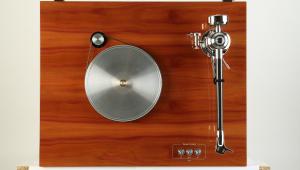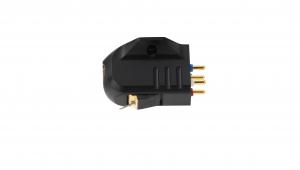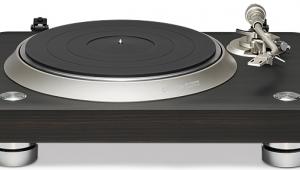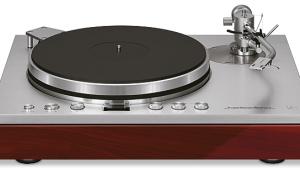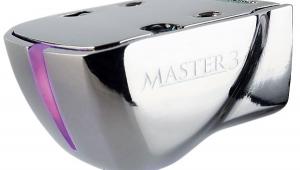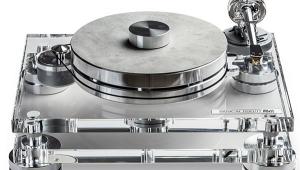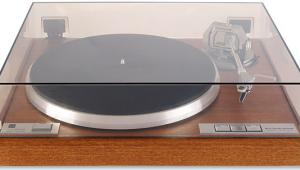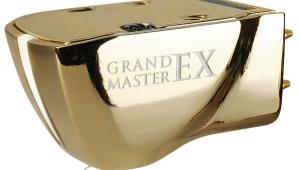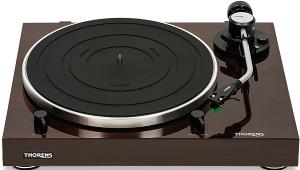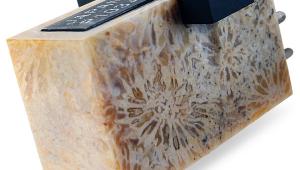Ortofon Cadenza Blue (£1000)
Facing the hard task of replacing Ortofon's successful Kontrapunkt moving-coils are the new Cadenza models. The ruby-cantilevered Blue is the first out to bat
It’s tough at the top. About 20 years ago, Ortofon started telling us that its aim was to survive by continuing to gain an increasing share of a fast-shrinking market, until the point would come when it would be the only cartridge-maker left standing.
This hasn’t happened, of course. There was a period when the numbers could be kept up only by pandering to the needs of DJs, whose destructive tendencies (fortunately) tended to help sales once you’d gained their loyalty; but eventually the shrinking hi-fi market stabilised.
Cartridges would never again sell by the lorry-load as they had done in the 1970s, but eventually the shrinkage gave way to green shoots of growth. If not the ‘last survivor’, Ortofon could now claim to be the world’s leading manufacturer.
Ortofon had launched its first moving-magnet cartridge in 1969 after 20 years of making only moving-coils. Today, those who want to mix and scratch can choose from 18 models in Ortofon’s completely separate DJ range. For those who like to listen to music rather than the sound of their own voices, the nine current hi-fi MM models still include the refined, but now Methusalah-like, OM series and a couple of P-mount versions alongside the newer, much punchier-sounding 2M models.
But if you are reading this, you really want a moving-coil. And if you’re prepared to budget between £750 and £1500, you’ll be looking at the new Cadenza series. In line with other Ortofon ranges, the Cadenzas are identified by colour. Gone are the Kontrapunkt’s musical initials. But as before, the range caters for subtle differences in sonic taste as well as providing a sensible quality hierarchy.
Starting from the top, the Cadenza Black seems most closely related to the seminal MC Jubilee, as both use a nude Shibata stylus mounted on a boron cantilever, and both are currently listed at £1500. The £1250 Cadenza Bronze uses an Ortofon Replicant 100 stylus, with tip radii of 5 and 100µm and giving an extra long vertical line contact, while its coils are wound with Ortofon’s Aucurum wire, which is gold-plated ‘6-nines’ copper.
In these aspects it resembles the high-end Windfeld, named as tribute to Ortofon’s just-retired chief designer Per Windfeld, but has an aluminium cantilever instead of the Windfeld’s boron rod. So, the Black and Bronze push upwards towards the high end, rather than replacing the Kontrapunkt C or H. But the Cadenza Red is a direct replacement for the base model Kontrapunkt A, using a basic line-contact stylus with tip radii of 8 and 40µm on an aluminium cantilever, its specification virtually unchanged.
Similarly, the Cadenza Blue replaces the Kontrapunkt B, retaining that beautiful thin ruby cantilever. The stylus, though, is a Fritz Gyger FG70, with minor/major radii of 5 and 70µm, instead of the FG80 with its major radius of 80µm.
WARMTH AND DELICACY
But paper specifications don’t reveal the effects of internal improvements in the new designs. I couldn’t wait to hear how the Cadenza Blue would actually sound, and got things started with Rob Wasserman’s Duets [GRP 97 121] and ‘Ballad Of The Runaway Horse’.
Here Jennifer Warnes’ voice had both depth and warmth, and great delicacy too, and this cartridge really seemed able to convey the endless subtleties of shading and nuance which the singer put into this performance.
Wasserman’s bass seemed very well described, with the subtle feathery edges of the sound adding to its realism. The pizzicato effect, where he overdubs a second bass and makes it sound like a big mandolin, was arrestingly clear.
Moving on to Eric Clapton’s ‘Motherless Children’, from 461 Ocean Boulevard [RSO 2479 118], I appreciated the Blue’s detail and precision. Rhythm guitars were twangy and sharp, while Radle’s bass was tight and declamatory in its anchoring role, defining the changes as well as the rhythm. Clapton’s vocal sounded a little over-sibilant.
Although by now I was getting attuned to the Ortofon’s abilities, the cartridge was still able to spring a pleasant surprise when I put on Dire Straits [Vertigo 9102 021]. On ‘Sultans Of Swing’, the Cadenza Blue seemed suddenly to bring more ambience and space into the sound, and though the open arena here is an atmosphere created artificially by a brilliant producer, it really was like a breath of fresh air. And I felt the Cadenza’s bass was particularly impressive on this track too, the bass guitar alive and springy, clean and strong.
TRULY BRASSY TOO
On a kind of music very different from Knopfler’s, although his mythical ‘Sultans of Swing’ would have appreciated it, the story was much the same, with an immediate openness and life to the sound. Listening to The King James Version [Sheffield Lab LAB-3] I found that the brass was truly brassy, and with excellent detail that made it easy to pick out, for example, the trombone lines in the ensemble.
When drummer Les DeMerle really let rip on ‘Cherokee’, the effect was dynamic and realistic, with great transient attack and a great sense of speed, as if things really started and stopped properly, a real thud to the tom-toms and a thoroughly convincing, singing cymbal sound with real presence.
I tried to come up to date a bit, but got sidetracked by something that was quintessentially retro when it appeared in 1978, Blondie’s Parallel Lines [Chrysalis CDL1192]. On ‘Sunday Girl’ for example, there was a great punch and clarity to the neatly interlocking guitar parts and you could only marvel at the tightness of the whole thing. Once again the well-shaped, accurate-sounding bass end, with a complete freedom from slurring, boom or overhang, helped make the music seem agile and full of energy.
After this I wanted to see what the appropriately-named Cadenza would do for classical music. With the 1967 Barenboim/ECO recording of Mozart’s Piano Concerto K467 [EMI ASD2465], the Ortofon’s clarity and precision made for a very enjoyable listen. The strings were sweeping rather than scarifying and, at the risk of overdoing the alliteration, I can only say you felt you were hearing detail, rather than distortion, in the treble.
At the opposite end of the spectrum, the clean and quick bass gave meaning to the sound of the double-basses and helped the recording sound rhythmically lightfooted, as I think it should. The piano had precision and subtlety, and seemed to exist in real space. All in all, the first movement whizzed by and I was wallowing in the ‘Elvira Madigan’ music before I knew it.
VERDICT
VERDICT
On the evidence of this model, it looks as if Ortofon really has improved on its excellent Kontrapunkts. If you want something to make your system to sound more cuddly and rounded, the Blue is not for you. But if you want a cartridge to give you detail, space, integrity and vitality, and fresh insights into every old-favourite LP you put on, the Cadenza Blue will do just fine. It’ll be hard to beat at the price.
Sound Quality: 87%
Sound Quality: 87%
Originally published in the March 2010 issue






